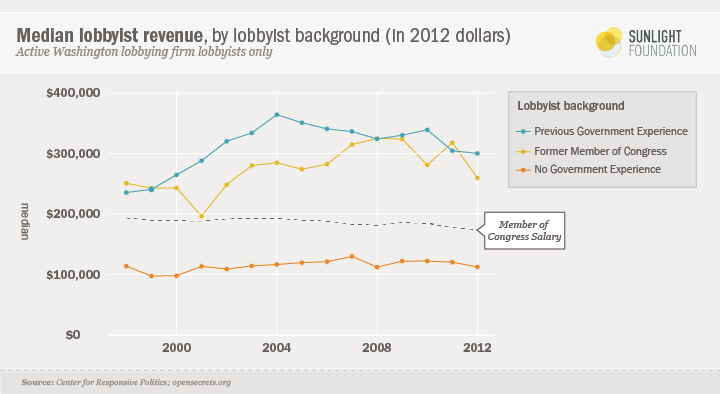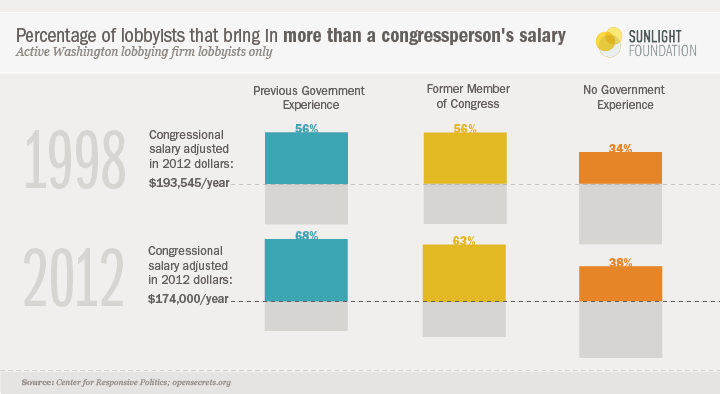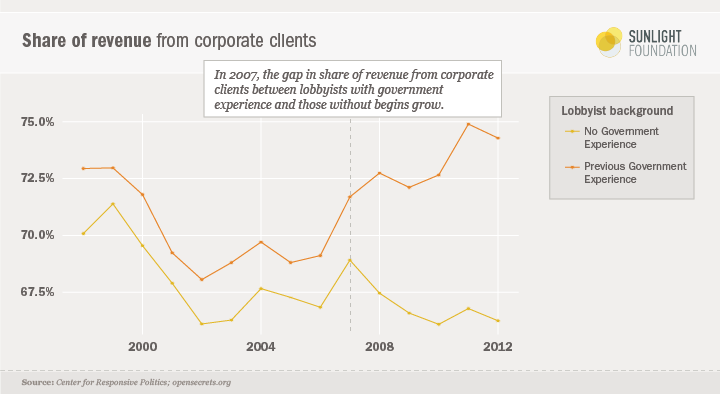K Street pays top dollar for revolving door talent
It is a widely accepted truism in Washington that the place to get rich is on “K Street” — that metonymic shorthand for the Washington lobbying business. But how rich?
In 2012, we estimate that the median active for-hire Washington lobbyist generated $179,667 in lobbying revenue. That’s slightly more than what a member of Congress earns ($174,000) — and has been slightly more since 2010, when the median revenue first eclipsed the member salary.
But clients appear to be willing to pay significantly more for “revolving door lobbyists” (those lobbyists with government experience) than they do for lobbyists without government experience.
For 2012, we estimate that lobbyists who list a government staff position somewhere in their lobbyist disclosure firms were associated with a median revenue of $300,000. That’s almost three times the median revenue we estimate that lobbyists without government experience generated: $112,500.

Roughly two-thirds of revolving door lobbyists now generate more revenue trying to influence legislation than lawmakers earn for writing legislation. By contrast, less than 40 percent of those who never worked in government appear to earn more money than members of Congress.

(Interestingly, former government staff generate even more money than former members of Congress. One plausible explanation is that members of Congress earn more revenue from vague responsibilities like strategic advisor or “historian” than they do from “lobbying” subject to LDA reporting requirements.)
While the gap has always existed, it has widened. In 1998, the revolving door premium was closer to twice the non-revolving door premium. And back in 1998, the majority of contract lobbyists didn’t have government experience (or, at least, disclosed government experience).
That “revolving door” lobbyists generate more revenue than their counterparts should not come as a surprise. Lobbyists with Hill experience are valuable. They have personal relationships and friendships with people who still work in Congress, and hence access. They know the quirks of the procedures, the personalities and who responds well to what. And often, they know the policy pretty well, too, having been around it for years.
These differences are also consistent with previous research. Both this paper and this paper also find that lobbyists who are well-connected earn a premium in the revenue they generate.
Revolvers are becoming more corporate
One reason might be that clients, especially corporations, are willing to pay more for the connections.
Interestingly, if we look at the percentage of lobbyists’ revenues coming from corporate clients, we notice an intriguing divergence starting in 2007. Prior to 2007, the overall share of lobbying revenue from corporate clients is slightly higher for revolving door lobbyists, as compared to lobbyists without government experience, but the difference is negligible.
Starting in 2007, revolving door lobbyists appear to depend more on corporate clients, while lobbyists without government experience start to depend less on corporate clients. By 2011, there is a noticeable eight percentage point gap, with revolvers depending on corporate clients for roughly three-quarters of their lobbying revenues, while lobbyists without government experience only get two-thirds of their revenue from corporate clients.

By corporate clients, we mean individual corporations, trade associations and business associations. All other interests are considered non-corporate.

